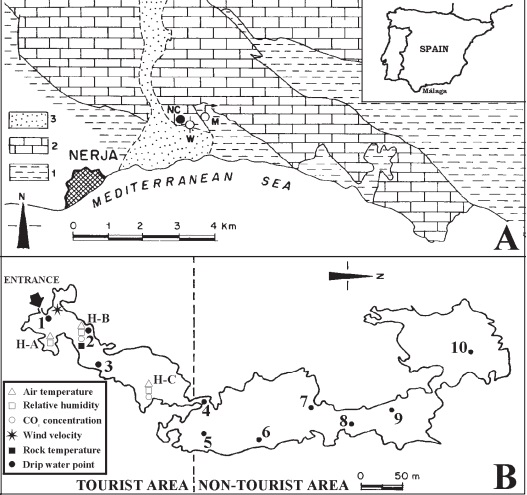Control of Environmental Parameters for Management and Conservation of Nerja Cave (Malaga, Spain)
DOI:
https://doi.org/10.3986/ac.v31i1.407Abstract
V povprečju obišče jamo Nerja ve~ kot 500.000 ljudi letno. Od leta 1993 je v jami instalirana mreža monitoringa, ki vsako uro meri številne parametre, da bi ugotovili vplive obiskovalcev na podzemno okolje. Od 1991 izvršujejo hidrokemične meritve vode v curkih v jami in pri naravnih iztokih iz karbonatnega vodonosnika. Zvezna merjenja fizikalno kemijskih parametrov prenikajoče vode, dnevni odtok, kakor tudi temperatura in relativna vlažnost zraka, koncentracija CO2 in temperatura skale kažejo človekov vpliv. Glavne spremembe okoljskih parametrov so naslednje: 1. zračna temperatura zraste za 0,2 °C na vsakih 1000 obiskovalcev na dan; 2. relativni porast relativne zračne vlage med 2 in 3 %, ki v poletnih dneh doseže nasičenost; 3. koncentracija CO2 v zraku narase do vrednosti med 500 in 700 ppm v obdobju manjšega obiska in za desetkratno izhodiščno vrednost ob času velikega obiska (2.800 ppm); 4. temperatura skale narase med 0,02 °C do 0,15 °C na dan in 5. PCO2 prenikajo~e vode izkazuje spremembe, naraščajoče med velikim obiskom in padajoči indeks nasičenosti karbonatnih mineralov.
The Nerja Cave receives on average more than 500,000 visitors per year. In order to know the possible impact in the underground environment by human visits, a monitoring network was installed since 1993, to control hourly several parameters. Also, since 1991 a hydrochemical control has been carried out in the drip water points of the cave and in the natural discharge points of the carbonate aquifer. This continuous record of physical-chemical parameters of drip water, its daily outflow, as well as temperature and relative humidity in the air, CO2 concentration and rock temperature shows the human influence. The main changes in environmental parameters are the following: 1. cave air temperature rises 0.2 °C by 1000 visitors/day; 2. a daily increase between 2 and 3 % in relative air humidity, reaching saturation on summer days; 3. CO2 concentration in air increases up to values between 500 and 700 ppm during low visitability periods and 10 times the background value during high visitability periods (2.800 ppm); 4. temperature of the rock rises between 0.02 °C and 0.15 °C/day, and (5) PCO2 of drip water also presents variations, increasing during the big influx of visits and decreasing the saturation index of carbonated minerals.
Downloads

Downloads
Published
How to Cite
Issue
Section
License
Authors guarantee that the work is their own original creation and does not infringe any statutory or common-law copyright or any proprietary right of any third party. In case of claims by third parties, authors commit their self to defend the interests of the publisher, and shall cover any potential costs.
More in: Submission chapter




